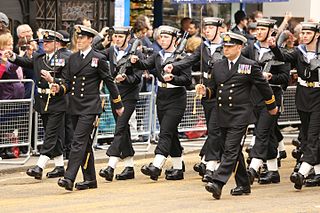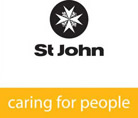
Mess dress uniform is the semi-formal type of uniforms used by military, police, fire and other public uniformed services for certain ceremonies, receptions, and celebrations, in messes or on private occasions. It frequently consists of a mess jacket, trousers, white dress shirt, often with standing collar and bow tie, along with orders and medals insignia. Design may depend on regiment or service branch, e.g. army, navy, air force, marines, etc. In Western dress codes, mess dress uniform is a permitted supplementary alternative equivalent to the civilian black tie for evening wear or black lounge suit for day wear - sometimes collectively called half dress - although military uniforms are the same for day and evening wear. As such, mess dress uniform is considered less formal than full dress uniform, but more formal than service dress uniform.

The peaked cap, service cap, forage cap, barracks cover or combination cap is a form of headgear worn by the armed forces of many nations, as well as many uniformed civilian organisations such as law enforcement agencies and fire departments. It derives its name from its short visor, which was historically made of polished leather but increasingly is made of a cheaper synthetic substitute.

Full dress uniform or parade dress uniform is the most formal type of uniforms used by military, police, fire and other public uniformed services for official parades, ceremonies, and receptions, including private ones such as marriages and funerals. Full dress uniforms typically include full-size orders and medals insignia. Styles tend to trace back to uniforms used during the 19th century, although the 20th century saw the adoption of mess-dress styled full-dress uniforms. Designs may depend on regiment or service branch. In Western dress codes, full dress uniform is a permitted supplementary alternative equivalent to the civilian white tie for evening wear or morning dress for day wear – sometimes collectively called full dress – although military uniforms are the same for day and evening wear. As such, full dress uniform is the most formal uniform, followed by the mess dress uniform.
The Uniforms of the Canadian Armed Forces are the official dress worn by members of Canada's military while on duty.

The uniforms of the British Army currently exist in twelve categories ranging from ceremonial uniforms to combat dress. Uniforms in the British Army are specific to the regiment to which a soldier belongs. Full dress presents the most differentiation between units, and there are fewer regimental distinctions between ceremonial dress, service dress, barrack dress and combat dress, though a level of regimental distinction runs throughout.

Service dress uniform is the informal type of uniform used by military, police, fire and other public uniformed services for everyday office, barracks and non-field duty purposes. It frequently consists of a jacket, trousers, white dress shirt, and neck tie, sometimes for ceremonial occasions along with orders and medals insignia. Design may depend on regiment or service branch, e.g. army, navy, air force, marines, etc. In Western dress codes, service dress uniform is a permitted supplementary alternative equivalent to the civilian suit - sometimes collectively called undress or "dress clothes". As such, service dress uniform is considered less formal than both full dress uniform and mess dress uniform, but more formal than casual wear combat uniform.
Police uniforms and equipment in the United Kingdom have varied considerably from the inception of what were the earliest recognisable mainstream police forces in the early 19th century. As various pieces of legislation in the middle part of the 19th century standardised policing in the United Kingdom, so too, did the uniforms and equipment become standardised. From a variety of home grown uniforms, bicycles, swords and pistols the British police force evolved in look and equipment through the long coats and top hat, to the recognisable modern uniform of a white shirt, black tie, reflective jackets, body armour, and the panda car, to the present-day Airwave radios, electric vehicles and tasers.

The modern Irish Army uniform is based on the layer principle and is designed to provide the soldier with the right degree of protection for any operational environment.

The Uniforms of the United States Marine Corps serve to distinguish Marines from members of other services. Among current uniforms in the United States Armed Forces, the Marine Corps dress uniforms have been in service the longest. The Marine Dress Blue uniform has, with few changes, been worn in essentially its current form since the late 19th century.

St John Ambulance is a volunteer-led, charitable non-governmental organisation dedicated to the teaching and practice of first aid in England. Along with St John Cymru-Wales and St John Ambulance Northern Ireland, St John Ambulance is one of three affiliates of the international St John Ambulance movement in the United Kingdom.

St. John Ambulance in Canada, or SJA (French: Ambulance Saint-Jean Canada, is a confederation of St John Ambulance Provincial and Territorial Councils under mandate by the "St John Councils Regulations 1975" of the Royal Charter, Statutes and Regulations of the Order of St John. Each Council is governed by a Board of Directors under Provincial or Territorial incorporating legislation together with the St John Ambulance Priory in Canada, incorporated under the federal Canada Not For Profit Corporations Act. The Priory provides support services to the Councils and manages the Order of St. John in Canada. The Councils deliver the mandate of training and community services and are responsible for their own governance, operations and management.
St John Ambulance Ireland (SJAI), previously known as the St John Ambulance Brigade of Ireland, is a charitable voluntary organisation in Ireland. For constitutional reasons it is not a full member association of the Venerable Order of Saint John and the international St. John Ambulance movement, but rather is classed as an "associated body". The organisation is dedicated to the teaching and practice of medical first aid. It is engaged in first aid training to the public, providing first aid and ambulance cover at public events, patient transport and community services.

The Order of Malta Ireland – Ambulance Corps is a voluntary ambulance and first aid organisation operating in Ireland in affiliation with the Sovereign Military Order of Malta, founded in 1938.

St John Singapore, previously known as St John Ambulance Singapore, is a voluntary secular organisation in Singapore which provides training in First Aid and Home Nursing. It is affiliated with the Order of St. John based in the UK. Its ambulance members and nursing members perform voluntary first aid coverage duties during national events and other events. It comprises 3 sub-organisations, namely the St John Brigade Singapore, St John Association Singapore, St John Fellowship Singapore.

The Royal Air Force uniform is the standardised military dress worn by members of the Royal Air Force. The predominant colours of Royal Air Force uniforms are blue-grey and Wedgwood blue. Many Commonwealth air forces' uniforms are also based on the RAF pattern, but with nationality shoulder flashes. Cadets of the RAFAC which includes the ATC and CCF (RAF) Sections wear similar uniforms.

The uniforms of the United States Air Force are the standardized military uniforms worn by airmen of the United States Air Force to distinguish themselves from the other services.

The uniforms of the Royal Navy have evolved gradually since the first uniform regulations for officers were issued in 1748. The predominant colours of Royal Navy uniforms are navy blue and white. Since reforms in 1997 male and female ratings have worn the same ceremonial uniform.
The uniforms of the United States Army distinguish soldiers from other service members. U.S. Army uniform designs have historically been influenced by British and French military traditions, as well as contemporary U.S. civilian fashion trends. The two primary uniforms of the modern U.S. Army are the Army Combat Uniform, used in operational environments, and the Army Service Uniform, worn during formal and ceremonial occasions.
The uniforms of the Royal Canadian Navy are a variety of different official dress worn by members of the Royal Canadian Navy while on duty. Originally, the uniforms of the RCN were modelled after their counterparts from the United Kingdom. However, after the RCN was merged with the Canadian Army, and the Royal Canadian Air Force in 1968 to form the single-service Canadian Armed Forces, the RCN began to wear "Canadian Armed Forces Green" uniforms, worn throughout the Canadian Armed Forces

The Royal Turks and Caicos Islands Police Force is the national police force of the Turks and Caicos Islands, a British Overseas Territory. It is one of the oldest police forces in the world.















